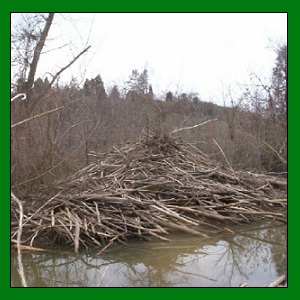Beaver Trapping and Control
Are beavers cutting down trees, building dams, flooding property, plugging culverts and causing bank erosion? OFWC can safely remove beavers using lethal traps and for long-term damage control, barriers can be built in culverts and other structures.
Identification
The beaver is a large, semi-aquatic rodent known for building dams and lodges. It has large, curved teeth, small ears, small front feet, large webbed back feet, a wide hairless tail, and weighs 40-60 lbs. The beaver is primarily nocturnal although may be seen a little before dark and after daylight.
Beavers build one or more dams using sticks, mud, rocks, and other debris in creeks, rivers, and pond spillways. The upstream side of the dam provides still, deep water to protect against predators, and to float food and building material.
Beavers live in either a lodge made of sticks, a bank den, or a combination of both. Entry to the lodge or den is underwater. Inside there is a shelf where the beaver can come out of the water.
Beaver kits are born in the springtime, Apr-June. The kits born the previous year are forced out of the colony at the end of summer and the beginning of fall. They go downstream or upstream or even across the land to find a mate and start their own colony. During winter, the average colony size is four, two adults and two youngsters. During summer, a colony size can be six or more.
Removal Method
Traps are set in the water in travel ways or at scent locations. The traps quickly dispatch the beaver. As beavers are caught, traps are reset and moved. If a dam exists it is breached to track activity. When tree chewing and dam maintenance stop, traps are removed. OFWC can help with the destruction of the lodge (if one exists) and can advise on deterrents to keep future beavers from building dams, clogging culverts, etc.




